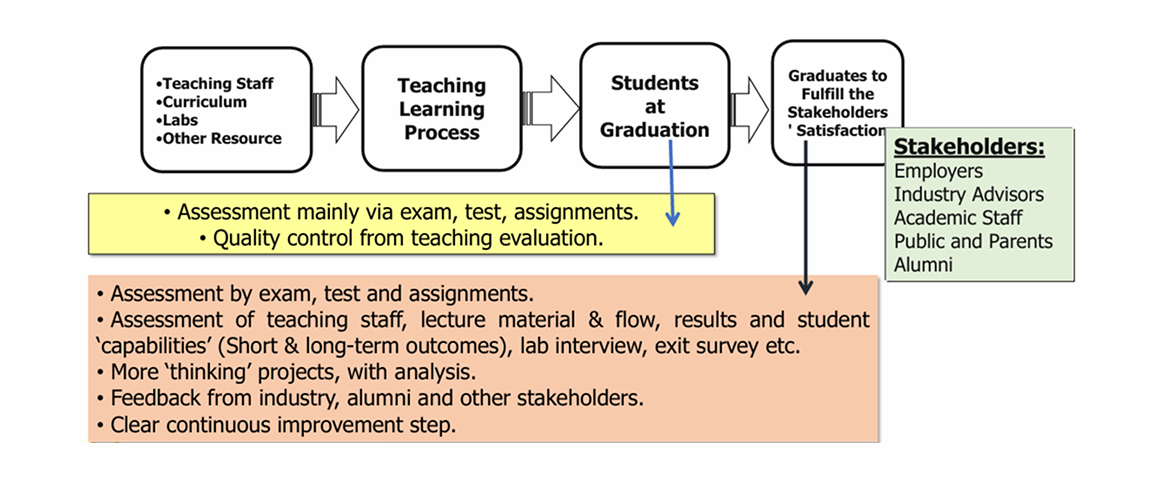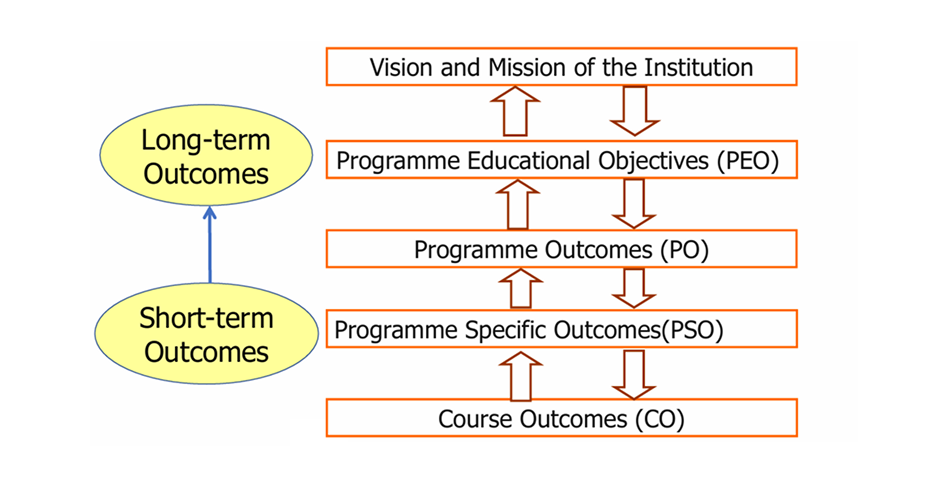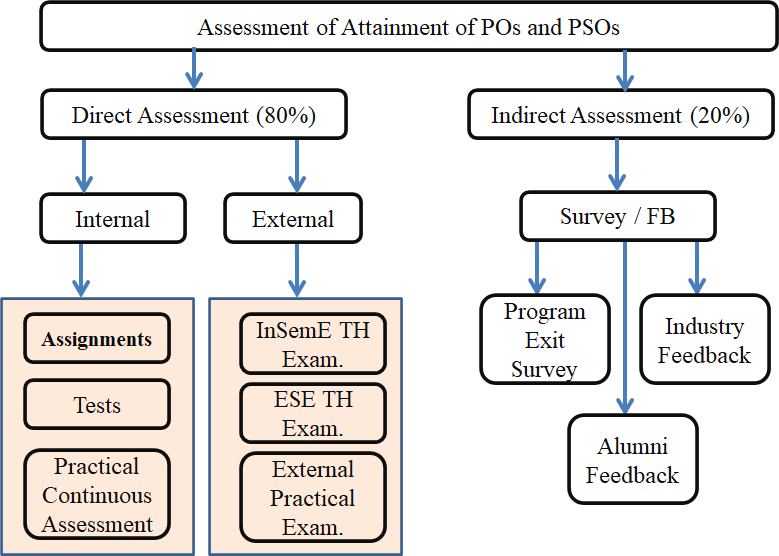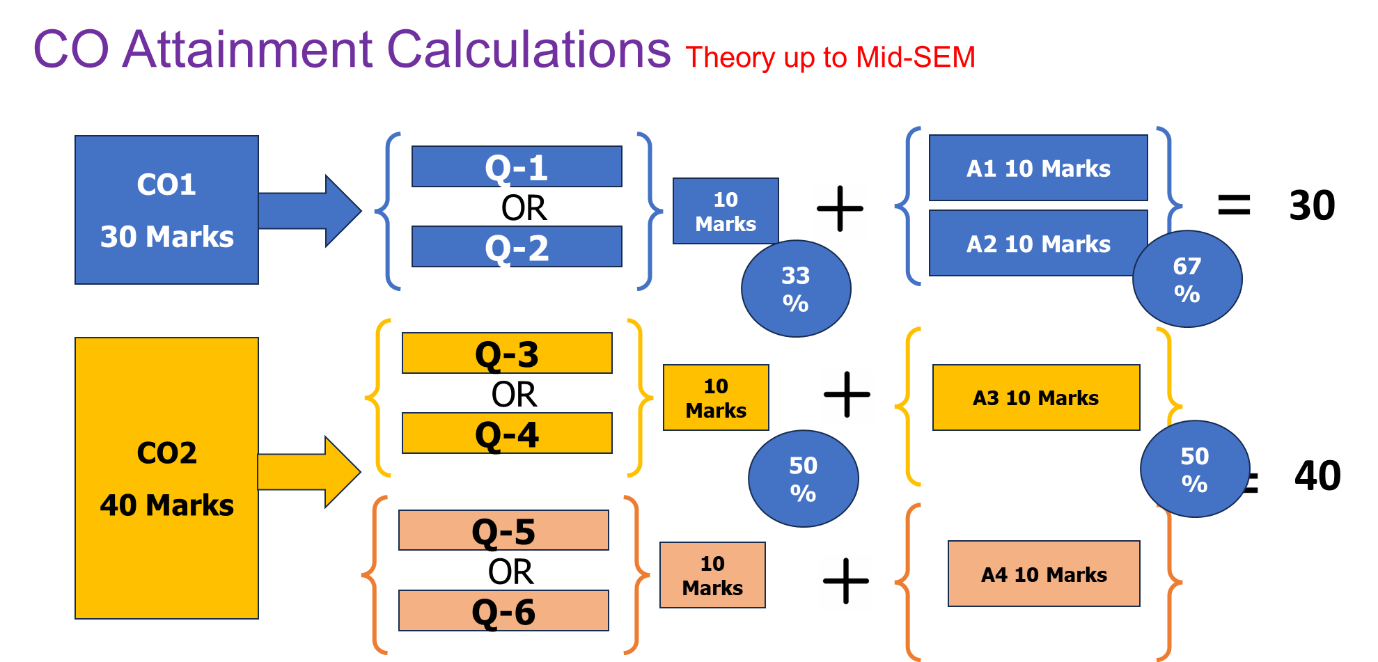Academics
- Dean Academics
- Programs Offered
- Academic Council (AC)
- Board of Studies (BoS)
- Academic Monitoring Committee (AMC)
- SPPU Academic Calendar
- Institute Academic Calendar
- OBE Philosophy & Implementation
- Autonomous Syllabus Structure FY B.Tech
- Autonomous Rules and Regulations
- Syllabus Structure SY, TY, B.Tech Computer Engineering
- Syllabus Structure SY, TY, B.Tech AI-Data Science
- Syllabus Structure SY, TY, B.Tech AI-Machine Learning
OBE Philosophy & Implementation
The traditional teaching system in education focuses on teachers’ inputs and presume that learning has occurred. The Outcome Based Education (OBE) is focusing on “what the students are capable of doing”.
The OBE is learner citric approach in which, it’s not important what we teach,
but it’s important what student learn

OBE Philosophy
The model which we are using is in favor of making students
demonstrate the SKILL to achieve required
Engineering Graduate Attributes.
This OBE model sets clear standards for observable,
measurable outcomes.
OBE v/s Traditional

Model Hierarchy of OBE

Since OBE focusses on student competency, it concentrates on the outcomes or goals instead of just marks or scores. Therefore, the goals which could be a certain number of skills and knowledge that the learner should have at the end of the course. The assessment methods are defined to measure the achievement of these goals. The teachers take the role of being facilitators and mentors. Constructive feedback from the students also helps in reshaping the additional Value-added Programs (VAP) and activities to be given to the students as shown in Figure.
OBE Implementation

Our Vision and Mission
Vision
To achieve excellence in quality education through value based rapidly changing technologies and create technical Human-Resource with proficiencies of accepting new challenges.
Mission
Continuously strive to impart value-based education to elevate the satisfaction level of all stakeholders. Take dedicated efforts to create competent professionals by effective teaching learning process with passion of lifelong learning attitude.. Our endeavor is to promote and support innovative research, entrepreneurship and development activities through Industry Interaction.
OBE Objectives

Objective 1:
To prepare graduates to apply their knowledge to solve real life problems

Objective 2:
Induct Professionalism, Soft-Skills, Social Awareness, and Responsibilities among the Faculty and Students

Objective 3:
Inculcate the urge for life–long learning and Professional Ethics

Objective 4:
Motivate students and faculty for vertical growth and to understand new trends in Technologies
Our Program Educational Objectives (PEOs)
PEO1: Prepare graduates to apply their Computer Engineering knowledge while framing the solutions to the real-life problems.
PEO2: Inculcate ability of communication, soft skills, ethics and work in a while demonstrating the professionalism.
PEO3:Impart life-long learning among faculty and students to adapt new trends and technologies in the field of Computer Engineering
OBE Philosophy & Implementation
The traditional teaching system in education focuses on teachers’ inputs and presume that learning has occurred. The Outcome Based Education (OBE) is focusing on “what the students are capable of doing”.
The OBE is learner citric approach in which, it’s not important what we teach,
but it’s important what student learn

OBE Philosophy
The model which we are using is in favor of making students
demonstrate the SKILL to achieve required
Engineering Graduate Attributes.
This OBE model sets clear standards for observable,
measurable outcomes.
OBE v/s Traditional
Model Hierarchy of OBE
Since OBE focusses on student competency, it concentrates on the outcomes or goals instead of just marks or scores. Therefore, the goals which could be a certain number of skills and knowledge that the learner should have at the end of the course. The assessment methods are defined to measure the achievement of these goals. The teachers take the role of being facilitators and mentors. Constructive feedback from the students also helps in reshaping the additional Value-added Programs (VAP) and activities to be given to the students as shown in Figure.
OBE Implementation

Our Vision and Mission
Attainment of Outcomes
- The Program Outcomes (POs) and Program Specific Outcomes (PSOs) are accomplished through curriculum
- Course Outcomes (COs) are defined for each course and they are mapped to POs and PSOs.
- A set of performance evaluation criteria is used for quantitative assessment of COs
- Thus, the attainment of COs provides evidence of attainment of POs and PSOs.
Measurement of Outcome Attainment
During the course of the programme, various measurement methods are used to measure the attainment of outcomes. The assessment of outcome attainment largely depends on the student’s performance output or marks obtained in final theory and practical examination, test, and submission of assignments which indicates students learning achievements. Therefore, it is necessary and important to carry out a proper attainment method in order to measure student learning achievement and to predict the student’s performance in future.
There are different ways to assess student learning. Different types of assessment approaches available and the different frame works to interpret the results are as follows:
· Continuous Internal Assessment (CIA) · Alternate Assessment Tools (AAT) · Mid-SEM Examination (MID-SEM) · End Semester Examination (ESE) · Laboratory Work (PR) · Mock Oral (OR) · Project work Presentation and Demo · Academic Audit Committee · IQAC Reviews · Course exit survey · Programme exit survey · Alumni survey · Employer survey · Course expert committee · Department Advisory Board (DAB) · Faculty meetings · Professional societies · Industrial Advisory Committee (IAC) |
Assessment Methods
Different methods for Assessment, Evaluation and Measurement of POs/PSOs are broadly classified as:
- Direct Assessment methods
- Indirect Assessment methods
The details of methods are as shown in Figure

- Continuous Assessment: COs are assessed through Mid-SEMSPPU examination & Assignment Examinations, Home Assignments, Tests and Lab records. The COs are mapped against each question and CO analysis is carried out by faculty for each course and documented. The contribution of COs are assessed in high, moderate and low levels, towards the attainment of POs/PSOs.
- Mid-SEM Theory Examination: The SPPU conducts Mid-SEM Examination (In-SEME) for the first two units of the course curriculum. The marks assigned for this examination are 30.
- End-SEM Theory Examinations: The questions in End SEM examinations are tested pertaining to all COs, in varying Blooms Taxonomy Levels. The SPPU conducts End-SEM Examination (ESE) for the last four units of the course curriculum. The marks assigned for this examination are 70.
- End-SEM PR/OR Examinations: The SPPU conducts ESE for Practical Courses either Practical or Oral examination. The marks assigned for these examinations are 25 or 50.
- Laboratory Records: Both continuous evaluation (in terms of term work) and End SEM examinations (in terms of PR/OR ESE) are conducted to test the COs attainment.








